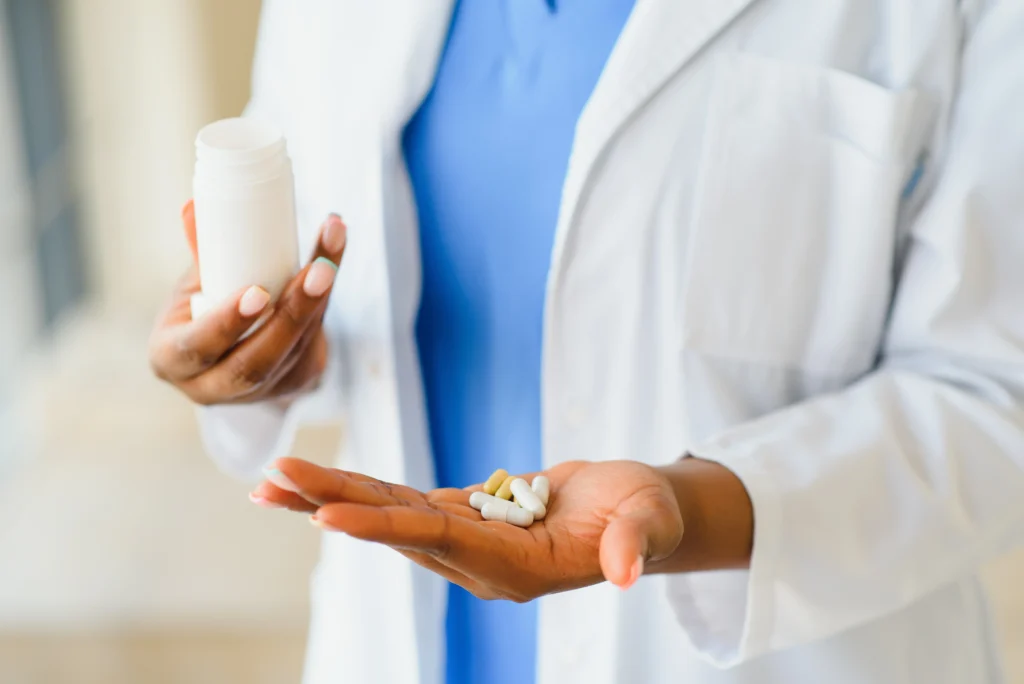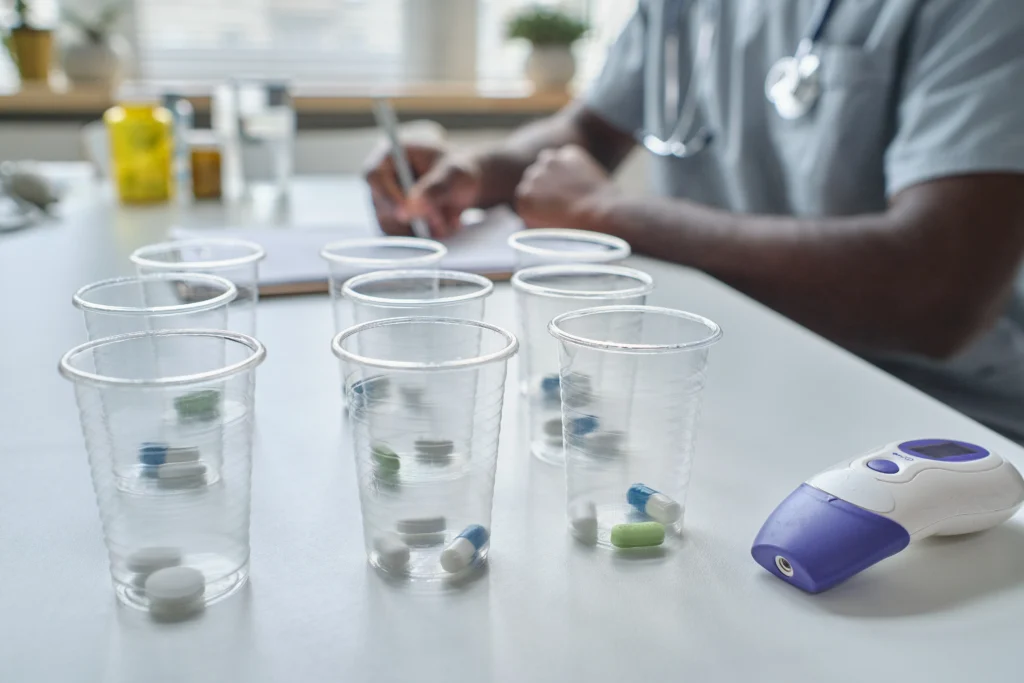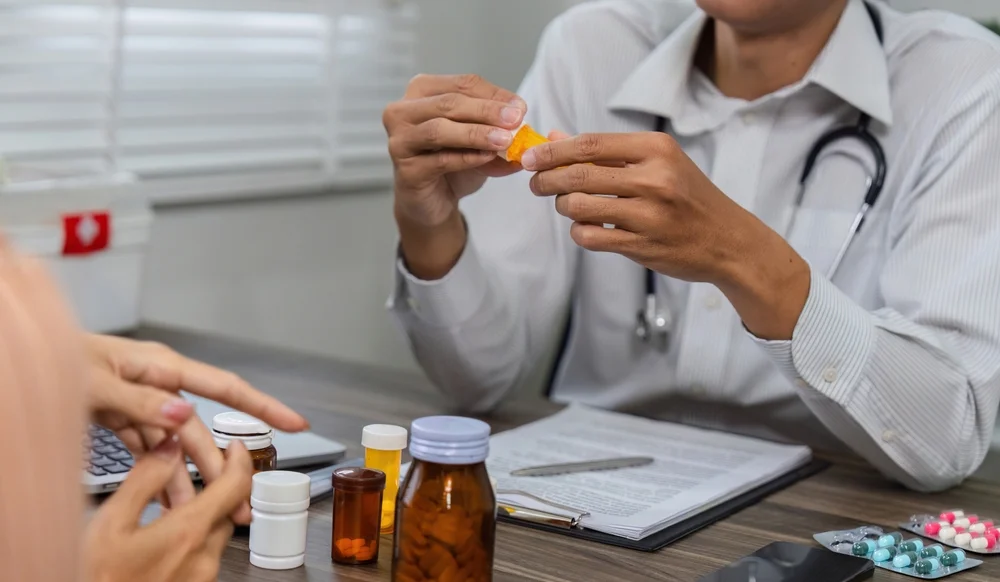Table of Contents
Toggle- What Is Therapeutic Duplication?
- Why Does Therapeutic Duplication Happen?
- Examples of Therapeutic Duplication
- Is Therapeutic Duplication Always Bad?
- The Risks of Therapeutic Duplication
- How Is Therapeutic Duplication Detected?
- How to Prevent Therapeutic Duplication
- What Should You Do If You Suspect Therapeutic Duplication?
- The Role of Pharmacists in Preventing Therapeutic Duplication
- The Importance of Patient Education
- Real-Life Scenarios of Therapeutic Duplication
- Therapeutic Duplication in Hospitals
- The Future of Preventing Therapeutic Duplication
- FAQs
- Conclusion
When it comes to healthcare and medication safety, one term you may come across is therapeutic duplication. At first, it might sound complicated, but the concept is actually quite simple once broken down. In basic terms, therapeutic duplication occurs when a person is prescribed two or more medications from the same therapeutic category or with the same intended effect.
This duplication can sometimes be intentional, but often it is not. When it happens by mistake, it may increase the risk of side effects, drug interactions, or unnecessary costs. Because of these concerns, healthcare providers and pharmacists pay close attention to therapeutic duplication as part of medication safety checks.
This guide will walk you through everything you need to know about the topic. By the end, you will understand not only what therapeutic duplication is, but also why it happens, what risks it poses, how it can be prevented, and what patients can do to protect themselves.
What Is Therapeutic Duplication?
Therapeutic duplication is the use of more than one medicine that belongs to the same therapeutic class, or that provides the same type of treatment effect. In other words, it happens when a person takes two or more drugs that essentially do the same job.
For example:
- A person might be prescribed two different types of painkillers that work in the same way.
- A patient might take two antihistamines for allergies without realizing they have overlapping effects.
- Someone with high blood pressure could be prescribed two medications from the same drug class, which could increase the risk of side effects.
This duplication can occur for many reasons, such as miscommunication between healthcare providers, overlapping prescriptions from multiple doctors, or simply a lack of awareness.
Why Does Therapeutic Duplication Happen?
Even with today’s advanced healthcare systems, therapeutic duplication is not rare. There are several common reasons it happens:
1. Multiple Healthcare Providers
Patients often see more than one doctor, especially if they have chronic conditions. Each provider may prescribe medications without full knowledge of what the other has prescribed.
2. Poor Medication Records
If medical records are incomplete or not updated, providers may not see the complete list of a patient’s medications, leading to duplicate therapies.
3. Similar-Sounding Medications
Sometimes drugs have similar names or are marketed under different brand names. A patient may end up with two drugs that are nearly identical but appear different at first glance.
4. Over-the-Counter Medications
Patients may add over-the-counter drugs or supplements to their routine without realizing they overlap with prescribed medications.
5. Lack of Patient Awareness
Patients may not always know what their medications are for. If they are unaware, they may not recognize when two medications serve the same purpose.
Examples of Therapeutic Duplication
To understand what therapeutic duplication is more clearly, here are a few practical examples:
- Pain Management: Taking two different non-steroidal anti-inflammatory drugs (NSAIDs) such as ibuprofen and naproxen. Both relieve pain and inflammation, but using them together increases the risk of stomach ulcers, kidney problems, and bleeding.
- Allergy Medications: Taking two antihistamines like diphenhydramine (Benadryl) and cetirizine (Zyrtec) at the same time. This duplication can cause extreme drowsiness and confusion.
- Blood Pressure Control: Using two medications from the same class, such as two beta-blockers, can lower blood pressure too much and cause dizziness or fainting.
- Cholesterol Management: Taking two statins, such as atorvastatin and simvastatin, can increase the risk of muscle pain and liver damage without offering additional benefits.

Is Therapeutic Duplication Always Bad?
Not always. In some cases, doctors may intentionally prescribe two medications from the same class for short-term use or in special medical situations. This is known as therapeutic overlap.
For example:
- In pain management, a doctor may combine different medications for stronger short-term relief.
- In cancer treatment, certain drug combinations may be used strategically for better outcomes.
However, when duplication happens unintentionally, it usually does not provide extra benefits and only increases risks.
The Risks of Therapeutic Duplication
Therapeutic duplication may cause serious problems if it goes unnoticed. The main risks include:
1. Side Effects
Using two drugs from the same class can double the risk of side effects. For instance, two sedatives taken together may cause excessive drowsiness and slow breathing.
2. Overdose
When drugs overlap, patients may unknowingly take more than the recommended dose of a certain type of medicine. This can lead to toxicity or poisoning.
3. Drug Interactions
Some medications, when taken together, interact in harmful ways. Duplication can increase the chances of such interactions.
4. Higher Costs
Patients may spend more money on extra medications they do not actually need.
5. Reduced Treatment Effectiveness
In some cases, duplication may not cause harm but may also not improve health. The patient ends up taking unnecessary medications without added benefits.
How Is Therapeutic Duplication Detected?
Healthcare professionals use several strategies to detect and prevent duplication:
- Pharmacy Systems: Most pharmacies have computer systems that alert pharmacists if a patient is prescribed two drugs from the same class.
- Medication Reconciliation: Hospitals and clinics often review a patient’s complete medication list when they are admitted or discharged.
- Pharmacist Review: Pharmacists regularly review prescriptions to ensure they do not overlap.
- Patient Interviews: Asking patients about all the medications they take, including over-the-counter and supplements, helps detect duplication.
How to Prevent Therapeutic Duplication
Both healthcare providers and patients play a role in prevention.
For Healthcare Providers:
- Keep complete and up-to-date medication records.
- Communicate with other providers treating the same patient.
- Use electronic prescribing systems with alerts for duplication.
For Patients:
- Share a full list of medications with every doctor you visit.
- Include over-the-counter medicines and supplements in your list.
- Use one pharmacy when possible, so pharmacists have your complete record.
- Ask your doctor or pharmacist if you are unsure why you are taking medication.
What Should You Do If You Suspect Therapeutic Duplication?
If you think you might be taking two drugs that do the same thing, here are the steps you can take:
- Do Not Stop on Your Own: Never stop taking a prescribed medicine without professional advice.
- Check With Your Pharmacist: Pharmacists are trained to recognize duplication and can quickly review your medication list.
- Talk to Your Doctor: Ask your doctor to explain why you are taking each medication and whether both are necessary.
- Keep a Medication List: Carry a written or digital list of your medicines and update it regularly.
The Role of Pharmacists in Preventing Therapeutic Duplication
Pharmacists are the last line of defense before a medication reaches a patient. They play a critical role in:
- Identifying duplicate therapies through advanced software systems.
- Educating patients about their medications.
- Contact doctors if they notice potential duplication.
- Monitoring side effects that may signal overlapping therapies.
This makes pharmacists essential partners in patient safety.
The Importance of Patient Education
One of the strongest tools in preventing therapeutic duplication is patient awareness. When patients understand what each of their medications is for, they are less likely to take unnecessary or overlapping drugs.
Healthcare providers can help by:
- Explaining each medication clearly.
- Writing down the purpose of each prescription.
- Encouraging patients to ask questions.
Patients, in turn, should feel empowered to seek clarity whenever they are unsure.
Real-Life Scenarios of Therapeutic Duplication
Case 1: Elderly Patient with Multiple Prescribers
An older adult sees a cardiologist, a primary care doctor, and a rheumatologist. Each prescribes medications, but because records are not fully shared, the patient ends up taking two different calcium channel blockers for high blood pressure. This duplication increases the risk of dangerously low blood pressure.
Case 2: Over-the-Counter Overlap
A patient takes prescription loratadine for allergies but also buys diphenhydramine over the counter for additional relief. Without realizing it, the patient is duplicating antihistamine therapy, which results in severe drowsiness.
Case 3: Chronic Pain Management
A patient receives prescriptions for ibuprofen and naproxen from two different doctors. Both are NSAIDs, and when taken together, the duplication raises the risk of stomach bleeding.
These cases show how easily duplication can happen and why careful management is necessary.
Therapeutic Duplication in Hospitals
Hospitals are especially cautious about duplication because patients are often prescribed multiple medications at once. To reduce risks, hospitals use strategies such as:
- Electronic medical records with alerts.
- Medication reconciliation during admission and discharge.
- Dedicated pharmacists who review all drug orders.
Despite these efforts, duplication can still occur if communication breaks down. That is why ongoing vigilance is so important.
The Future of Preventing Therapeutic Duplication
Advances in digital health may make duplication easier to prevent. Some promising developments include:
- Integrated Electronic Health Records (EHRs) that allow providers to see all medications from different doctors.
- Artificial Intelligence Tools that can predict and flag duplication risks before prescriptions are finalized.
- Mobile Apps that help patients track and organize their medications in one place.
As technology improves, the hope is that duplication will become less common.

FAQs
1. What is therapeutic duplication in simple words?
Therapeutic duplication means taking two or more medicines that do the same job. This often happens by mistake and may increase the risk of side effects or overdose.
2. Is therapeutic duplication always dangerous?
Not always. Sometimes doctors intentionally prescribe two similar medicines for a short time or for special treatments. However, most unplanned duplication does not add benefits and may cause harm.
3. How common is therapeutic duplication?
It is more common than many people realize, especially in patients who see multiple doctors or take many medications at once. Older adults are particularly at risk.
4. Can over-the-counter drugs cause therapeutic duplication?
Yes. Many people take non-prescription medicines or supplements without knowing they overlap with their prescribed medications. This can easily lead to duplication.
5. What are the risks of therapeutic duplication?
The main risks include stronger side effects, overdose, harmful drug interactions, wasted money, and in some cases reduced effectiveness of treatment.
6. How do doctors and pharmacists detect therapeutic duplication?
They use electronic systems, medication reviews, and patient interviews. Pharmacies often have alerts that notify pharmacists if two drugs belong to the same therapeutic class.
7. What should I do if I think I am taking duplicate medications?
Do not stop any medication on your own. Speak to your pharmacist or doctor right away. They can review your medicines and adjust your treatment if needed.
8. Can therapeutic duplication happen with vitamins or herbal products?
Yes. Even natural products can overlap in effect with prescription drugs. For example, taking two supplements that thin the blood may increase bleeding risks.
9. How can I prevent therapeutic duplication?
Keep an updated list of all your medications, including over-the-counter drugs and supplements. Share it with every doctor you see and try to use the same pharmacy for all prescriptions.
10. Who is most at risk of therapeutic duplication?
People who take multiple medications, older adults, patients with chronic conditions, and those who see several healthcare providers are at the highest risk.
Conclusion
So, what is therapeutic duplication? It is the use of two or more medications from the same class or with the same effect, often by mistake. While sometimes intentional, unplanned duplication increases the risks of side effects, overdose, drug interactions, and unnecessary costs.
The good news is that therapeutic duplication can be prevented through good communication, careful record keeping, and patient education. Pharmacists, doctors, and patients all play a role in reducing duplication and improving safety.
By understanding this concept and staying informed, you can make better decisions about your healthcare and protect yourself from unnecessary risks.






